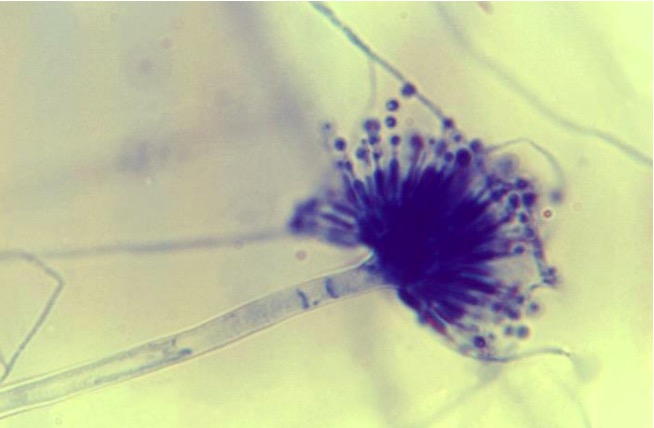Playlist
Show Playlist
Hide Playlist
Aspergillosis – Opportunistic Infections
-
Slides 08 OpportunisticFungalInfections MicrobiologyAdvanced.pdf
-
Download Lecture Overview
00:01 Alright so that's our second opportunistic fungal infection. Here's another one and this one is called aspergillosis. It's called by the species Aspergillus. These are again environmental filamentous fungi; they are not part of our normal flora. So if you recall the first yeast that we talked about, Candida are normal flora in humans, it's only when our immune system is perturbed in some way, they become pathogenic, but aspergilli are not members of our normal flora. Aspergilli are normal inhabitants of the environment. Most people breathe aspergillus spores every day. I'm probably breathing some right now and so are you, but we're fine breathing these, we don't get sick. Some of us may have an allergic reaction, it's only when we are either neutropenic, again we have low levels of neutrophils which are important for combating a lot of these fungal infections, or if on corticosteroids or if we're transplant recipient and we're being immunosuppressed to prevent rejection of the organ, in those cases then an aspergillus inhalation of spores can lead to severe disease. Now aspergillus, we inhale the spores initially and when they go into our lungs, they germinate and they start to grow as hyphae. So here's a case where initially the spores become hyphae and these are invasive. 01:37 They can go from the lung tissues into the blood vessels, through the blood vessel walls and then they can spread elsewhere from there. They can destroy the blood vessel as a result of this mycelial growth. They can cause hemorrhaging and destruction or necrosis of the vessels and surrounding tissues. So the hyphal growth in a tissue is associated with particularly nasty effects. 02:01 Neutrophils as you might guess and macrophages are the main host defense against aspergillosis. 02:05 And I suspect that in most of us with a healthy immune system, as soon as we inhale a spore, our lung is full of phagocytic cells, macrophage cells that can take up spores, but they can't take up the hyphae. So if the spores germinate and get to the point where they start to develop hyphae and a mycelium, the macrophages can't handle that, but the neutrophils can take care of that. Again in an immunocompetent individual, neutrophils secrete reactive oxygen species that will kill the hyphae. So even in you or I who are immunocompetent, if a few of the spores germinate and form hyphae the neutrophils can take care of them. Again it's only in people with compromised immune systems, these cells are not functional and the hyphal growth continues unabated. Inhalation of spores and growth is initially accompanied by pulmonary or sinus infections, which may be mistaken for a flu-like illness or allergies, but then again, if the immune system is defective, you will get hemorrhagic infarctions as the hyphae invade various tissues and this can happen in many parts of the body as well as the brain. When we have pulmonary invasion by the hyphae, this is called invasive pulmonary aspergillosis, it's associated with fever, chest pain, cough and shortness of breath or dyspnea. The growth of the fungus not only invades the brain, in immunocompromised people can cause brain abscesses, but can also cause necrotic skin lesions, which are typical of the infection. 03:48 How do we diagnose and treat aspergillosis? It's easy to culture Aspergillus in the laboratory, but because the spores are everywhere, it's very important to differentiate contamination in the lab from actual infection. So because again, it's so pervasive, this is not easy to do even in a clean laboratory. We can take biopsies of various tissues to document invasion and we can see the typical cellular forms or the hyphal forms of the Aspergillus and then when confirmed, we can then treat with voriconazole, amphotericin B and caspofungin. 04:28 So that's aspergillosis. That's a common environmental fungus. That again, it's opportunistic because it causes problems in immunosuppressed individuals.
About the Lecture
The lecture Aspergillosis – Opportunistic Infections by Vincent Racaniello, PhD is from the course Fungi.
Included Quiz Questions
Which of the following statements about Aspergillus is FALSE?
- It is part of the normal flora of the human body.
- It is the pathogen that causes aspergillosis.
- It is a filamentous fungus.
- It is commonly found in the environment.
- It can disseminate from the lungs to the blood vessels.
Most pathological effects of Aspergillus occur because of which of the following?
- Growth of Aspergillus hyphae
- Acidic pH of Aspergillus
- Basic pH Aspergillus
- Nutrient demand of Aspergillus
- Interaction between Aspergillus and RBCs
Through which of the following mechanisms do neutrophils kill Aspergillus hyphae?
- Release of reactive oxygen species
- Direct phagocytosis
- Release of prolactin
- Formation of nucleic acid nets
- Release of CCL4
Customer reviews
5,0 of 5 stars
| 5 Stars |
|
5 |
| 4 Stars |
|
0 |
| 3 Stars |
|
0 |
| 2 Stars |
|
0 |
| 1 Star |
|
0 |




